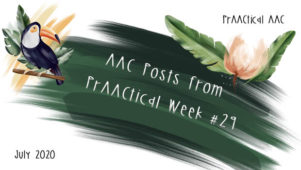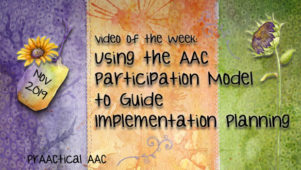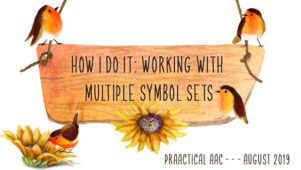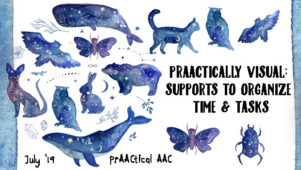Beyond The Core: Guide to Teaching New Words for Students Who Use AAC
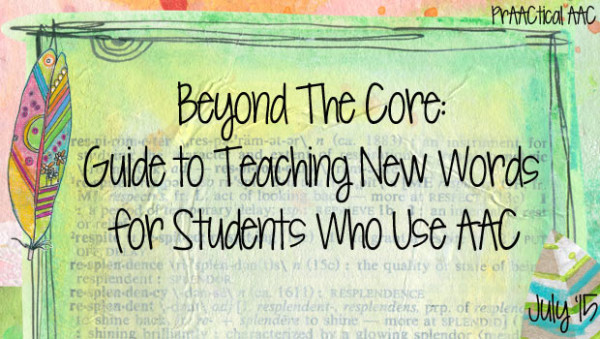
Teaching AAC learners to expand their vocabularies beyond a basic set of core words is an important goal to target in language development, and a topic that we’ve written a lot about in this space. For the student to be successful, SLPs need to think of vocabulary instruction as an ongoing process that has a clear 3-part structure.
- Introduction: Word is used in context, defined, and produced by the learner. Students assess their own knowledge of the word.
- Explicit Instruction: Activities are created to help the student really understand what the word means and how to use it. Students begin using it throughout the session.
- Continued Practice: We continue to use these words and help the student use the target words in the session. Engaging activities, often with technology, are used to help our learners deepen their understanding of the word.
This will be accomplished over multiple sessions. In this post, there is information about how to address this with vocabulary words that were taught previously and those that you are just now introducing. Consider using some of these ideas for students who have a basic set of core words but need to further develop their language abilities.
WORDS FROM PREVIOUS LESSONS/SEMESTERS
In preparation
- Poster or large chart with the target words in alphabetical order; 2 colors of markers/pens; Some kind of stand so that it is visible and w/in reach throughout the session.
- Clinician should be prepared with the student-friendly definition of each word on the poster/chart.
- Start the session reviewing the agenda and reminding the learners that we want them to use the big, sophisticated, words that they’ve been learning. (Setting the expectation is something that helps all of us learn and achieve.)
- Words are visible on a poster or large chart
- SLP uses Focused Language Stimulation throughout the session. We use the student-friendly definition of the target word when we use it in context the first time. (E.g., No wonder that you were outraged by that! No wonder that made you extremely angry!; Great! Your sentence contained a lot of High School words. There were lots of big words inside your sentence!)
- When we say them, we make a mark next to the word on the poster/chart. (Good for metalinguistics AND it will cue you as to which words we haven’t yet used).
- When the student says the target word(s), make a mark with a different color, and provide instructive feedback.
- Actively elicit words that the student didn’t say spontaneously but could have used. (E.g., Good thought! How could you say that using a big word instead of ‘angry’?)
- Provide instructive feedback on the use of the word. If the student used it correctly, solidify the learning (E.g., ‘Yes, it contained verbs and adverbs. Your sentence included verbs and adverbs. They were inside your sentence.’). If he/she used it incorrectly, model the correct form (e.g., ‘She invitationed me.’ ‘Oh, she invited you. You got an invitation.’) or explain where she went wrong (e.g., ‘I was outraged that she came 5 minutes late.’ ‘I can see why you were upset. But outraged is a lot stronger than just upset, right? Outraged means really, REALLY angry. And being 5 minutes late doesn’t usually make us that mad. Let’s think of other words that mean upset and see if there is a better one to describe how you felt.’)
NEW WORDS That are Being Taught for the First Time
In preparation
- Create a personal dictionary using PowerPoint, Keynote, or other presentation software/apps. This will start with 1-2 words and we will add to it weekly as we work together to build a deeper and deeper understanding of the word. We can send that to the learner electronically whenever it is updated so that they can use it in the classroom and at home.
- Create the visual support for each word that has the word, a student-friendly definition, an image for the word, and the word used in a sentence. This is used in the session, but also goes into the learner’s personal dictionary.
- Brainstorming Paper: Take notes as you and the client discuss the word. Put the comments into sections on the paper. E.g. Related words/ideas; Things the word is NOT (Includes but is not limited to opposites); examples; other forms of the word.
- Create a blank semantic web that has the word at the center and areas for: meaning, part of speech, related words/ideas, things this word is NOT (includes but is not limited to opposites), other forms of the word, sample sentences (starting with the root word and then using the varied word forms).
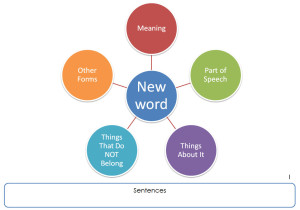
- Create scenarios that are clear examples of the word, and others that are clear NON-examples. (Contrast is a powerful teaching strategy.) We will also do this kind of activity when you are teaching different forms of the word.
- Develop materials for a word-pair sorting task. This would include about 12 index cards with the target word paired with another word (that she already knows) plus large chart with these columns: Same/Similar, Opposite, Not Related. The chart should be big enough so that the index cards fit into the appropriate columns without covering up anything else.
- Create a sentence substitution task. Sentences will have words similar to your target vocabulary words. It’s important not to use any unfamiliar words in these sentences. Underline the similar words, and have her tell you which vocabulary word should be put into its place. Students will use this in learning to substitute a new word for the old ones.
- Learn about apps and websites for digital collages, word clouds, digital storytelling, avatars, etc so that you can use them in your sessions. They are a very engaging way to keep the interest and enthusiasm for semantic work going strong!
- Prepare for Language Experience Surveys by: pre-storing the messages on her device and arranging for colleagues to be available to participate in the survey.
In the sessions
- Use the word in context.
- Tell the student the word that you’ll be teaching, and use a rating form to have him/her self-assess knowledge of the word.
- Use the word in context w/ student friendly definition.
- Show visual support for that word, review meaning and discuss image.
- Have the student say the word.
- Give examples of the word, and contrast that with clear non-examples. Have the student say the word several times as you discuss this.
*Brainstorm things that you both know and think about that relate to this word (e.g., when we’d use it, things that go with it, things that are NOT associated this this word, examples, etc.). This is a conversation with both of you contributing. Write/make notes as you go.Bring out a blank semantic web and begin to complete it. Have the student tell you the word, and then write it down on the semantic web.
- Have the student give you a definition, and you write it down on the web.
- Have him/her give you some examples, and you write them down.
- Use a judgment task where you go through your examples and NON-examples and the student tells you whether it is a good example of the word, NOT a good example, or she isn’t sure. You can have him/her do a thumbs up/down, and a so-so/maybe gesture for her response.
- Implement the word pair sorting activity. Provide instructive feedback as you go (as described earlier) whether the student gets it right or wrong.
- Return to the semantic web and continue to develop it together. Add new ideas based on the things learned/discussed since that was first introduced.
Throughout the session, have the student say the word frequently.
- Teach other forms of the word. Discuss the differences. Give examples of correct and incorrect usage.
- Create a judgment task, this time with different forms of the word in each sentence. Some sentences should be correct, and others incorrect. The student makes the judgment and then you can have him/her make the correction for the ones that are used incorrectly.
- Create a word cloud using websites like Wordle to make a visual support for the word. Look back at previous materials to generate ideas for what to put into the word cloud (E.g., visual support for the word, the semantic web, brainstorm sheet, word-pair sort, etc). Save it and add to the student personal word dictionary.
- Work together to create a digital collage using PicCollage, PicMonkey, or another app/website. It should have the word, student-friendly definition and 3-5 images that represent or are associated with the target word. Save it and add to the student’s personal word dictionary.
- Develop a Language Experience Survey that focuses on the target word. In doing this, you will help prepare the student to ask other people (survey them) in a way that uses the target word. For example: “Do you have time for a question? I am learning some new words and ___ is one of them. Can you tell me about a time when you were ___ed?” You will need to help her pre-program this so that it goes quickly. You’ll also need to pre-arrange some adults or classmates who are standing by willing to be asked these questions.
- Use a digital storytelling app or website, like Tellagami, Shadow Puppet or Morpho, to create a narrative around the target word. Co-create the narrative so that it uses the target word appropriately, is fun and engaging. Save it and link to it in the student’s personal word dictionary.
- Update the personal dictionary, as needed, and provide your student with an e-copy of it.
- Provide the student with home practice experiences that help him/her further develop knowledge and skills around the target word. Some examples of things that you can have the do:
– Email you with some pictures that go along with the target word
– Look up opposites on Word Hippo and send those to you in an email
– Use the word with someone, and then come prepared to tell you about it in the next therapy session.
– Ask someone a question about their experiences with the word (like you did in the Language Experience Survey), and be ready to tell about that in the next therapy session.
- Continue to use the word throughout the sessions for the next several months, elicit it often from the student, and provide instructive feedback when it is used.
- Create a bar graph of the student’s use of new words. Periodically, make a point to review that with him/her in the session so that the students see how their skills are growing. This keeps the momentum going strong!
Do you have ideas for activities or teaching strategies that we can add to this process? We’d love to hear about them.
Filed under: PrAACtical Thinking
Tagged With: academic vocabulary, implementation ideas, intervention, semantic instruction, vocabulary teaching
This post was written by Carole Zangari

